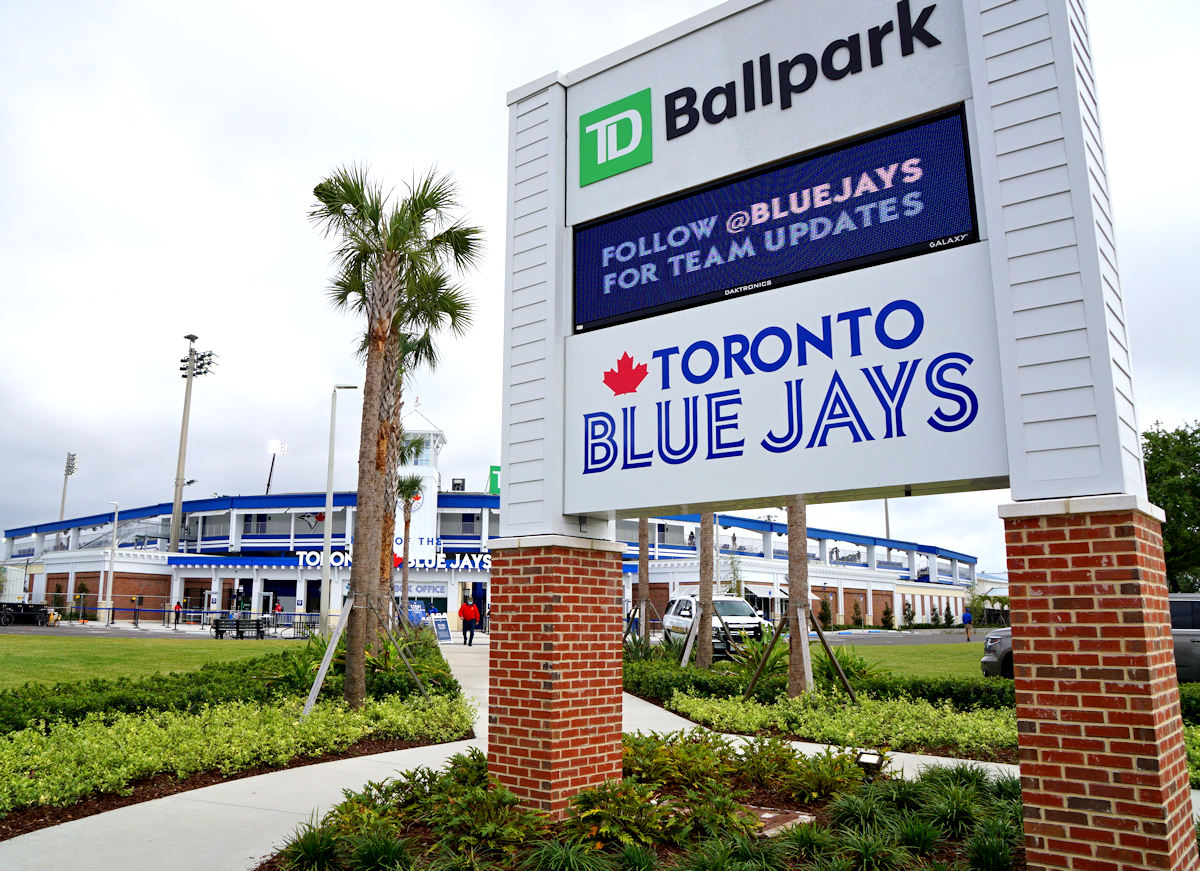
Article and photos by Joe Mock, BaseballParks.com
An abbreviated version of this article appeared in USA TODAY Sports Weekly. Used by permission.
DUNEDIN, Florida If you’re old enough, you no doubt remember the bitter players’ strike that started in 1994. The major issue was a salary cap – the owners badly wanted it and the players weren’t having it.
| Ballpark Stats |
 |
| Team: Toronto Blue Jays and Dunedin Blue Jays (Low-A Southeast League) |
| First MLB regular season game: April 8, 2021 – Angels 7, Blue Jays 5 in 11 innings |
| Capacity: 8,400. 2021 games are played with 23% capacity |
| Dimensions: LF – 328; LCF – 375; CF – 400; RCF – 375; RF – 328. The wall is 10′ tall in LF and CF, 13’10” in RF |
| Architect for 2020 renovation: Populous. Lead Project Designer – Mike Sabatini; Lead Project Architects – Spencer Scherer and Bruce Marshall |
| Construction for 2020 renovation: Gilbane/Turner |
| Cost of 2020 renovation: $38 million |
| Home dugout: 1B side |
| Field points: southeast |
| Playing surface: Latitude 36 bermudagrass |
| Naming rights: purchased by TD Bank |
| Betcha didn’t know: Before the renovation, the souvenir shop was underneath the 1B grandstand. Now that space is a women’s restroom. |
| Photo above by Colin Cushing |
The strike wiped out the last seven weeks of the regular season, and probably killed the interest in the City of Montreal to keep the Expos around and build a new ballpark. That was because the Expos had arguably the best team in baseball in ‘94 – but since the playoffs and World Series never happened, they didn’t have the chance to show it.
The other Canadian team, the Blue Jays of Toronto, had a different story to tell from that period. When the strike failed to be resolved over the winter and dragged on through spring training, someone came up with the bright idea of using “replacement players.” Most MLB teams went along with the crazy idea, because they wanted to break the union and force the players’ reps to give into the owners’ desire for a salary cap.
The plan went like this: all MLB teams (with the exception of the Orioles, whose owner was pro-union attorney Peter Angelos) would go through spring training in 1995 with former Major Leaguers and cast-offs, and if the players’ union hadn’t given in by the end of March, those “replacements” would actually play real games – that would count in the standings! – in the teams’ home ballparks.
As galling as this seems when you look back on the idea a quarter of a century later, the owners were prepared to play games in front of paying fans in Fenway, Yankee Stadium, Dodger Stadium, etc.
But the Blue Jays had a problem. The Province of Ontario had regulations that made it illegal to use strike-breaking employees to take the place of the original employees who’d walked off a job. That meant that if MLB owners were going to carry out their plan, the Blue Jays couldn’t use their replacement players in Toronto.
So the team had to find an alternate site. That site, as it turns out, was Dunedin Stadium, where the team had played its spring training exhibitions since the expansion team was founded in 1977. This plan went so far as to have MLB officials examine the facility to see if it was fit for regular-season games.
Would games that count have been played there once the ’95 season got underway with replacement players? Who knows, because the strike ended because of a court ruling against the owners the day before the regular season was to begin. When the delayed season began, the Blue Jays were playing in their normal SkyDome (now called Rogers Centre) home.
Now, as you’ve probably heard, the Blue Jays really are playing regular season games at the ballpark in Dunedin. It barely resembles the way the park looked in 1995, following a $12-million renovation in 2000 and a massive $38-million rebuilding starting in 2019.
How does the remodeled stadium – now called TD Ballpark — stack up as a (temporary) regular-season home for a Major League team? Before we take a look, let’s talk about “limited capacity.”
A record low
Due to chilly weather and general apathy toward a team that finished next-to-last in 1935, the official attendance for the St. Louis Browns’ 1936 home opener was only 1,500. It might actually have been less than that, because in those days, the attendance was estimated by a sportswriter rather than an accurate count of tickets sold. But let’s assume it was about 1,500.
| Pre-renovation |
 |
| I visited this park during the Florida State League season in 2018, when it was already known that a major facelift was coming. The entry then looked very drab compared to the photo at the top of this page. |
According to attendance guru David Kronheim of the firm Number Tamer, that was the smallest crowd since 1900 for a team’s first home game of the season, excluding make-ups for rain outs.
Since all records are made to be broken, we now have a new record low.
When the Blue Jays played their first home game of the 2021 season on April 8, not only was it the smallest paid crowd ever for a big-league home opener at 1,348, it was also 1,359 miles away from Toronto’s Rogers Centre.
The team’s spring-training home in Dunedin, Florida, was being pressed into service as the Blue Jays’ regular-season home, at least for the first few homestands on the schedule.
Usually the phrase “extended spring training” applies to a player who is sticking around the training complex while his teammates head off to start the season. In this case, it also applies to a ballpark.
Following extensive renovations completed last year, TD Ballpark has a capacity of about 8,400. In the regular season, the Blue Jays originally announced they’d be following the same health and safety protocols as during spring training, which meant that the “limited capacity” would be about 1,200 fans. Then after spring training was over, they revised it, saying things had gone so well around Florida in March that they were going to allow a total of 1,900 instead. Of course, some of those are comps for players’ families, umps, staff, etc.
So the paid crowd of 1,348 on April 8 (won by the Angels in 11 innings) is the smallest for a big-league home opener on record. Don’t belittle the Jays for the low attendance, though. The game is considered a sellout.
Home was away from home
The renovations to TD Ballpark were quite extensive, part of a $102 million facelift for both the park and the training complex, which is three-and-a-half miles away. And since the planning for the modifications began in 2018, the changes were envisioned long before a pandemic arrived, changing baseball schedules – and life in general – significantly.
| Buffalo home |
 |
| When the Jays weren’t allowed to play in Toronto in 2020, they settled into Sahlen Field in Buffalo for their regular season games. |
During the abbreviated 2020 season, the Blue Jays were the only MLB team who played no games in the stadium they usually call home. Instead, the entire home season was held at Sahlen Field in Buffalo. This is normally the home turf of the Jays’ Triple-A affiliate, the Buffalo Bisons, but since the entire Minor League season was wiped out in 2020, it created no scheduling conflict.
Last year, the season didn’t start until July. This year, it’s already underway, when the weather in Buffalo can be iffy. Since the team was already in Dunedin, they didn’t need to “break camp” and set up shop elsewhere, only to have to move again when restrictions on crossing the U.S.-Canada border lessen.
So the decision to play regular-season games in Dunedin was based largely on the pleasant spring climate in the Tampa area and the simplicity of remaining where spring training took place, a spokesperson for the Blue Jays told us.
The team wants to return to Rogers Centre as soon as possible, but team president and CEO Mark Shapiro knows that there are plenty of obstacles to be overcome first.
In a recent interview with TSN, Shapiro listed three factors that will be included in a pitch to the city of Toronto to permit the return of the team to Rogers Centre. First, the Blue Jays can show that they’ve had no positive COVID cases among players or staff since the abbreviated season began last July. Second, team officials will work closely with health officials in Ontario province and Toronto on health protocols. Third, players, coaches and staff need to be vaccinated.
Realistically, Shapiro thinks it will be June before a proposal can be made to return the team to its home base. It’s a foregone conclusion that the first games at Rogers Centre will be without fans.
In the meantime, Dunedin will continue to be the Blue Jays’ home base. If it appears that a return to Toronto won’t happen until well into summer, the team will consider heading to last year’s home park in Buffalo, most likely after the third or fourth homestand of the season. That will be in June, when Dunedin’s weather will be hot, sticky and filled with pop-up showers, while Buffalo will be more pleasant. In addition, renovations spearheaded by the Jays at Sahlen Field should be completed by then.
With complications like the parent club perhaps coming to Buffalo again this summer plus the ongoing renovations, the Bisons decided to hedge their bets and move their entire season to Trenton for 2021. That means Sahlen Field will be wide open for the Blue Jays if they need to move their home schedule there.
Let’s look at the renovations made at Dunedin’s TD Ballpark, and what further work had to be done to get ready for big-league regular-season contests.
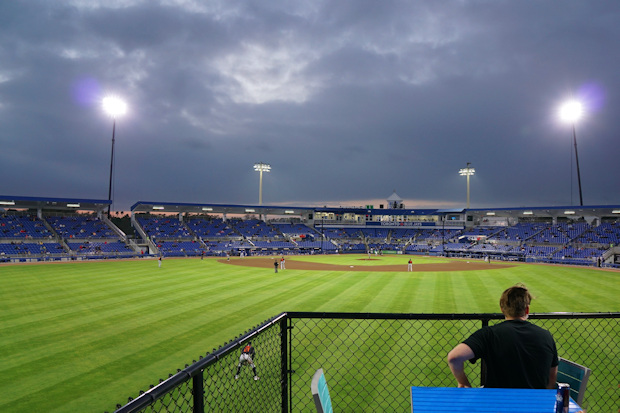
Pre-pandemic planning
Mike Sabatini, principal at sports-architecture giant Populous, first spoke to the folks at the City of Dunedin in 2017 about what renovations could be done to their ballpark, and roughly what they may cost. By July 2018, a contract was signed, and the team at Populous, led by Sabatini, started the design work in earnest.
Note that this was a year and a half before anyone had heard the term “coronavirus.” In other words, the changes to the ballpark were done without a pandemic in mind. But those changes have helped implement COVID-protocols during spring training and, ultimately, to get ready for regular-season big-league baseball in 2021.
“The City of Dunedin wanted a new image for the facility that felt more like it belonged in the neighborhood, as well as improved fan comforts and a space for community functions,” Sabatini told us. As for the Blue Jays, “they wanted the same, plus improved fan experiences, improvements to the player amenities at the stadium and a new visitors’ clubhouse.”
When the plans were completed, it meant all aspects of the facility would be addressed: the dugouts; the playing surface (with better drainage); the food-prep areas; meeting space; a catwalk around the outfield; concourse; scoreboard; the light towers; sound system; press box; suites; and even the toilets. In fact, the outfield dimensions were changed so that they matched those at Rogers Centre.
One interesting objective by the team was to have the ballpark “branded” with Blue Jays logos and photos. So in addition to the structure itself looking much more like the residential structures around Dunedin, the concourses and seating bowl glisten with Blue Jays’ blue on a stark-white background. It is a great look.
Shedding more light
Even with renovations that included new lights and a new visitor clubhouse, TD Ballpark needed modifications before it was ready for regular-season baseball on the Major League level — especially during this age of COVID.
While the lighting was sufficient for the Low-A Minor League games that will be played here (the Dunedin Blue Jays play in the Low-A Southeast League), it’s not enough for big-league games. Four large light towers have been trucked in to provide brighter and higher sources of light, on a par with other MLB stadiums.
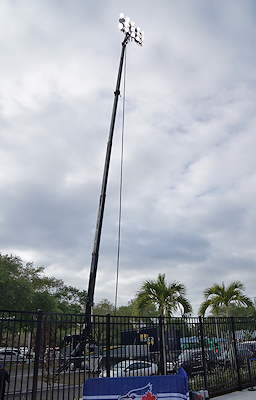 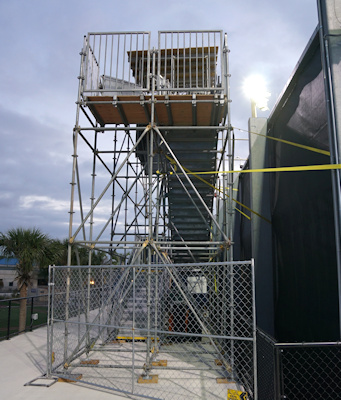 |
| Two features of TD Ballpark that will be removed once the Blue Jays move their regular-season games back to Toronto will be the four portable light towers (to provide lighting more reminiscent of big-league stadiums) and scaffolding for TV cameras. |
Knowing that the games would be televised prompted the Jays to construct scaffolding that rises above the batter’s eye in center field. The perch allows cameras to look over the pitcher’s shoulder as he delivers the ball.
There’s a brand-new video board above the left-field catwalk. It was really purchased with spring training games in mind, but it’s a welcome feature for these regular-season contests.
And the new visitor clubhouse isn’t large enough to meet MLB’s requirements for spacing between lockers, so a new BBQ garden behind third base is now a temporary structure to house the overflow. Fans can look into the area from a walkway and see lockers that are spaced far apart.
For the fans lucky enough to snare one of the limited number of seats, they are encountering somewhat limited concession choices. This should allow food to be delivered more quickly, reducing the need for fans to crowd around the stands waiting for their order. That’s the thinking anyway – but several menu items were added for the regular season games.
At the Local Favorites stand behind 1B, there were grouper tacos (two) with chips for $14.75 and an order of gator bites is $13.75. Both the Italian sausage and bratwurst cost $9.50. These prices seem high – but are reminiscent of what you’d pay in Rogers Centre. I’m told that once the big-league club moves out and it’s just Minor League ball this summer, the prices will come down.
The renovations created a very nice merchandise shop in a separate structure along the park’s perimeter. This allows it to be open on non-game days. It’s a shame, though, that there weren’t apparel items made to commemorate the special nature of regular-season games being played there.
It would’ve been nice if the renovations could have removed the very thick poles holding up the netting. The number of poles has been reduced, but the ones now in place are fairly obtrusive.
Ticket prices are certainly higher than for exhibition games, roughly triple or quadruple what fans paid during spring training. Colin Cushing, a fan from Washington, DC, doesn’t mind. He was anxious to see a regular-season game at TD Ballpark, so he grabbed two seats for the home opener as soon as they went on sale. “I paid $100 per seat in the 200 level. Given it’s a small ballpark, that’s probably in line with good seats for a regular season game at a Major League park.” Cushing would know, as his visit here was his 52nd different park seeing an MLB game.
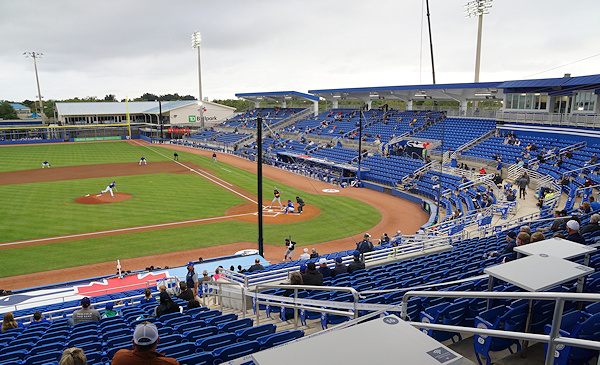 The color scheme is nice and bright now, but the very thick poles holding the netting are a distraction. By the way, the table tops in the foreground are for the press, since there isn’t sufficient room within the pressbox to keep the reporters socially distanced. The color scheme is nice and bright now, but the very thick poles holding the netting are a distraction. By the way, the table tops in the foreground are for the press, since there isn’t sufficient room within the pressbox to keep the reporters socially distanced. |
So while seats are closer to the field than most fans might be able to afford at, say, Rogers Centre, the sounds heard at TD Ballpark are unavoidable. That’s because crowd noise is being piped into the park through the PA system. The team spokesperson told us the sounds aren’t for the fans. They are for the players, and so the game sounds more natural on TV.
When they experimented with canned noise during exhibitions, most found it a bit jarring. Says one security guard whose post is near a speaker, “It’s deafening. I’d complain, but they probably wouldn’t hear me over the roar coming through the PA.”
Thankfully, when regular-season games started, the volume was a little lower. However, Cushing still feels such contrived sounds are “lame. What’s wrong with hearing the natural sounds of the game?”
Longtime pro-baseball broadcaster Doug Greenwald was also in attendance at the home opener on April 8. Like Cushing, he’s been to a lot of parks, this being the 50th where he’s attended a Major League game. He observed that “with the size of the park and number of fans present, the atmosphere was very much like a spring-training game.” That doesn’t mean that it was devoid of excitement, though. Greenwald noted that “What really made it unique was that the Angels were the opponent, and they’d never played a game in Dunedin. Plus Mike Trout hit a long home run, and that gave it extra zest.”
Residents in the neighborhoods surrounding the park are used to spring games being played in the afternoons. For years resourceful neighbors have charged fans to park in their driveways or front lawns for exhibitions, because there is almost no parking adjacent to TD Ballpark. The families who live nearby can’t be fond of the lights and (especially) noise from the big-league night games, but they no doubt are enjoying charging a premium for front-yard parking spots.
Mock covers sports facilities for USA TODAY publications
As a Toronto resident, I can report that COVID is currently raging in Ontario with daily records for new cases and hospitalizations. As a result, the provincial government has announced new lockdown protocols that at this point could last through the summer.
Right now it looks like the Jays won’t be playing games in the Rogers Centre this season unless Ontario is able to make a big turnaround in our COVID situation.